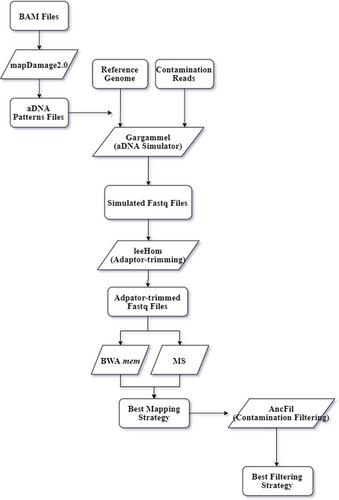当前位置:
X-MOL 学术
›
Ecol. Evol.
›
论文详情
Our official English website, www.x-mol.net, welcomes your
feedback! (Note: you will need to create a separate account there.)
An efficient pipeline for ancient DNA mapping and recovery of endogenous ancient DNA from whole‐genome sequencing data
Ecology and Evolution ( IF 2.3 ) Pub Date : 2020-12-21 , DOI: 10.1002/ece3.7056 Wenhao Xu 1, 2 , Yu Lin 3, 4 , Keliang Zhao 1, 5 , Haimeng Li 3, 6 , Yinping Tian 3 , Jacob Njaramba Ngatia 7 , Yue Ma 7 , Sunil Kumar Sahu 3 , Huabing Guo 8 , Xiaosen Guo 3, 9 , Yan Chun Xu 7 , Huan Liu 3, 10 , Karsten Kristiansen 3, 10 , Tianming Lan 3, 10 , Xinying Zhou 1, 5
Ecology and Evolution ( IF 2.3 ) Pub Date : 2020-12-21 , DOI: 10.1002/ece3.7056 Wenhao Xu 1, 2 , Yu Lin 3, 4 , Keliang Zhao 1, 5 , Haimeng Li 3, 6 , Yinping Tian 3 , Jacob Njaramba Ngatia 7 , Yue Ma 7 , Sunil Kumar Sahu 3 , Huabing Guo 8 , Xiaosen Guo 3, 9 , Yan Chun Xu 7 , Huan Liu 3, 10 , Karsten Kristiansen 3, 10 , Tianming Lan 3, 10 , Xinying Zhou 1, 5
Affiliation

|
Ancient DNA research has developed rapidly over the past few decades due to improvements in PCR and next‐generation sequencing (NGS) technologies, but challenges still exist. One major challenge in relation to ancient DNA research is to recover genuine endogenous ancient DNA sequences from raw sequencing data. This is often difficult due to degradation of ancient DNA and high levels of contamination, especially homologous contamination that has extremely similar genetic background with that of the real ancient DNA. In this study, we collected whole‐genome sequencing (WGS) data from 6 ancient samples to compare different mapping algorithms. To further explore more effective methods to separate endogenous DNA from homologous contaminations, we attempted to recover reads based on ancient DNA specific characteristics of deamination, depurination, and DNA fragmentation with different parameters. We propose a quick and improved pipeline for separating endogenous ancient DNA while simultaneously decreasing homologous contaminations to very low proportions. Our goal in this research was to develop useful recommendations for ancient DNA mapping and for separation of endogenous DNA to facilitate future studies of ancient DNA.
中文翻译:

用于古 DNA 作图和从全基因组测序数据中恢复内源古 DNA 的有效管道
由于 PCR 和下一代测序 (NGS) 技术的进步,古代 DNA 研究在过去几十年中发展迅速,但挑战仍然存在。古 DNA 研究的一大挑战是从原始测序数据中恢复真正的内源古 DNA 序列。由于古代DNA的降解和高水平的污染,尤其是与真正的古代DNA具有极其相似的遗传背景的同源污染,这通常很困难。在这项研究中,我们收集了 6 个古代样本的全基因组测序 (WGS) 数据,以比较不同的作图算法。为了进一步探索更有效的方法将内源 DNA 与同源污染分离,我们尝试根据古 DNA 的脱氨、脱嘌呤和不同参数的 DNA 片段化特征来恢复读数。我们提出了一种快速且改进的管道,用于分离内源性古 DNA,同时将同源污染减少到非常低的比例。我们这项研究的目标是为古代 DNA 作图和内源 DNA 分离提出有用的建议,以促进未来对古代 DNA 的研究。
更新日期:2021-01-08
中文翻译:

用于古 DNA 作图和从全基因组测序数据中恢复内源古 DNA 的有效管道
由于 PCR 和下一代测序 (NGS) 技术的进步,古代 DNA 研究在过去几十年中发展迅速,但挑战仍然存在。古 DNA 研究的一大挑战是从原始测序数据中恢复真正的内源古 DNA 序列。由于古代DNA的降解和高水平的污染,尤其是与真正的古代DNA具有极其相似的遗传背景的同源污染,这通常很困难。在这项研究中,我们收集了 6 个古代样本的全基因组测序 (WGS) 数据,以比较不同的作图算法。为了进一步探索更有效的方法将内源 DNA 与同源污染分离,我们尝试根据古 DNA 的脱氨、脱嘌呤和不同参数的 DNA 片段化特征来恢复读数。我们提出了一种快速且改进的管道,用于分离内源性古 DNA,同时将同源污染减少到非常低的比例。我们这项研究的目标是为古代 DNA 作图和内源 DNA 分离提出有用的建议,以促进未来对古代 DNA 的研究。











































 京公网安备 11010802027423号
京公网安备 11010802027423号